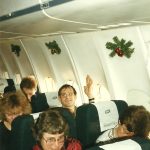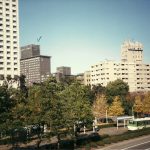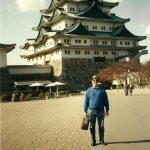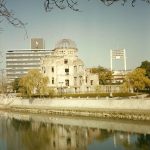My Musical Career|Part Thirty-Six
The Year 1988 – Part Two
Japan 1988
The big event of the year 1988 was the orchestra’s first ever tour to Japan in November and December. This would turn out to be the first of many visits the orchestra would make to Japan, and for me, it would turn out to be the first of three tours during my tenure.
The programs for the tour concerts were built around two programs: the first featured the Sibelius 2nd Symphony, and the second concert featured the Dvorak’s “New World” Symphony. Each concert had its overture and concerto, and I am having trouble remembering exactly what was played when and in what order, except for the symphonies. EMI was pushing our recordings big in Japan, as was evidenced in the record/CD shops in Tokyo.
For this tour, we had the complete set of Light Metros with Remo heads, and I spend a few days getting them cleaned up and ready for the tour. The percussion section included Matts Nilsson as principal; Trygve Wefring as assistant principal; Per Erik Thorsen, and Bjørn Løken as extra. We boarded the buses and headed out to Gardemoen Airport – which at the time handled only the larger and longer flights – short range flights to Britain and other parts of Scandinavia as well as Europe flew out of Fornebu, which was much closer to Oslo. Since our flight was going to last nearly ten hours, we were flying out of Gardemoen.
This was my longest flight to date, and I think it was for a good number of the orchestra as well. Scandinavian Airlines was the airline of choice, and I must say it was a comfortable flight. No incidents, and as we flew over Siberia, the pilot announced that fact to us, although it was dark when we were flying over that part of the world, so nothing was to be seen.
We landed at Tokyo’s Narita Airport, and as I got off the plane, I noticed right away that we were in the Far East. It was a gorgeously sunny day, with a clear blue sky. What I must noticed, and so did my colleagues, was the smell. It was not an unpleasant smell, not by any means, but it smelled almost like saffron, and it not super strong, but it was definitely there.
We got through customs within an hour and a half, and then were bussed into Tokyo. The drive in was interesting, as the rules of the road were the same as in Britain. We took in the sights from our bus window, but to tell the truth, all of us were looking forward to getting to our hotel rooms and take a shower and go to bed. The powers that be wisely gave us two extra days after arrival to recuperate after the long flight. We soon arrived at our hotel for the next few days. I
going to bed. A wonderful hotel and it was our home base for about a week as we did concerts in the Tokyo area, and again near the close of the tour. Cities visited on this first Japan tour included Tokyo, Osaka, Nagoya, Hiroshima, Fukuoka, and Sendai among others. There was a lot of travel between cities, as they were located on different islands. This meant that we had to travel by train, and this meant the “Shinkansen” – or “Bullet Train.” This is the famous high-speed inter-city train that travels at speeds of up to 150 miles per hour. (This was back in 1988) – it might even be faster today. For us, it was an experience. The trains were clean, the travel smooth – as a matter of fact, it was hard to tell that one was traveling so fast, unless one looked at the window and see the scenery just fly by. Our longest trip by Shinkansen was from Tokyo to Osaka and back. The distance is 313 miles, and it took about two and a half hours, quite quick at 150 mph. We had an extra day to get acclimated, as I said earlier in this post, and we used it to walk about Tokyo. One thing that we all noticed was the incredible number of people on the streets. Tokyo’s population is about eighteen million, and it seemed like all of them were on the streets at the same time. The stores on the Ginza (Tokyo’s 5th Avenue) were numerous and well stocked, and the CD/record shops –especially Yamano Music -were fully stocked, as were the electronic and camera shops. You can tell where my interest was (and still is).
I was not very adventurous gastronomically, and looked for and found a McDonalds right on the Ginza, and pretty much stuck to that and Western fare, while my colleagues were more adventurous.
The concerts on the tour were a great success. The orchestra was on top form, and the audiences were extremely enthusiastic. The best halls were Suntory Hall in Tokyo, and the Osaka Concert Hall in Osaka. Nagoya had a good hall as well. But Suntory Hall was perhaps the best of them, and if I am not mistaken, it is the most prestigious, sort of like what Carnegie Hall is to Americans.
Emotionally, the most interesting part of our side trips was a visit to the Hiroshima Peace Park with my colleagues Stig Nilsson, Pauls Ezergailis, and Arne Jørgen Øian. The peace park is built on the spot known as Ground Zero, where the atomic bomb was dropped on August 6, 1945. There is a beautiful little white shrine at the spot, and about three hundred yards away is the famous A-dome building. I met my friends from the viola section, Geoffrey Gotch and Rolf Ulfrstad there, and we spent a half hour there discussing that notorious day in 1945. The atmosphere was then, and still is, I am told, like that of a church. As soon as you go into the park, talking ceases, and as one reads the placards telling of the event and ponders the fact that one is on the exact site of Ground Zero – one gets very pensive indeed. Here is an extract of my journal entry from that day:
Entry 2: 3rd December, 1988
Hiroshima, JAPAN
Today was rather special, as the Orchestra is staying overnight in Hiroshima. Just the thought of being here gives me the chills. Just over forty-three years ago, the first atomic bomb was dropped here, and to think that I stood at ground zero! A very sobering thought. Though tonight’s concert went well, it was almost incidental to the thoughts and happenings of the day. As soon as we arrived this morning, I headed out with Pauls Ezergailis, Arne Jørgen Øian and Stig Nilsson to the Peace Memorial Park and Museum, which was built right at Ground Zero, which is the spot where the bomb burst. We were talking and bantering in the taxicab, but by the time we got to the museum, and got in it, we were silent, in memory of all those souls who perished in the inferno. For me, after visiting the museum and seeing the artifacts and remains of the blast, especially the A-dome building, it is inconceivable to me that mankind could ever do something like that to bring down such devastation on others. The after-effects of the bomb were gruesome, to put it mildly. It should be a lesson for all humanity to heed.
I need not say more.
No Principal Percussionist Yet
In my previous post, I mentioned that we hired a principal percussionist to replace the late Per Melsæter in the spring of 1988, with effect from 1 August of that year. Matts Nilsson joined the orchestra at that time and participated in concerts, two of our EMI recording sessions and our Japan tour. His playing was first-rate, and personally I got along well with him very well. However, there was another side to the story which I became aware of only after the tour. I did sense that Matts was lonely and a bit homesick, and wondered if it might affect his attitude at some point. This is not the place to discuss the reasons why things turned out the way they did, but shortly after the tour, when I found out that there was some discussion about Matt’s probationary status, I wasn’t surprised.
As things turned out, Matts returned to Sweden, and our search continued, although we did have a runner-up in the audition, Christian Berg. It was decided that we would contact him and offer him a trial period with the orchestra from mid-January 1989 until after our German/Austrian tour. (Things turned out well in the end for Matts, as he was so good a player that he soon was appointed to a position with the Swedish Radio Symphony.)
]





Recent Comments